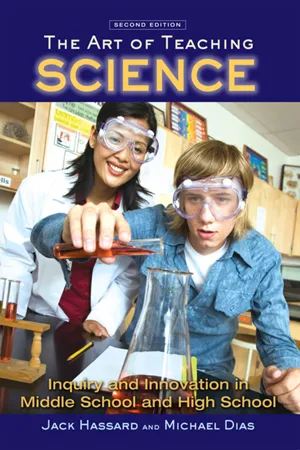
The Art of Teaching Science
Inquiry and Innovation in Middle School and High School
- 560 pages
- English
- ePUB (mobile friendly)
- Available on iOS & Android
The Art of Teaching Science
Inquiry and Innovation in Middle School and High School
About this book
The Art of Teaching Science emphasizes a humanistic, experiential, and constructivist approach to teaching and learning, and integrates a wide variety of pedagogical tools. Becoming a science teacher is a creative process, and this innovative textbook encourages students to construct ideas about science teaching through their interactions with peers, mentors, and instructors, and through hands-on, minds-on activities designed to foster a collaborative, thoughtful learning environment.
This second edition retains key features such as inquiry-based activities and case studies throughout, while simultaneously adding new material on the impact of standardized testing on inquiry-based science, and explicit links to science teaching standards. Also included are expanded resources like a comprehensive website, a streamlined format and updated content, making the experiential tools in the book even more useful for both pre- and in-service science teachers.
Special Features:
- Each chapter is organized into two sections: one that focuses on content and theme; and one that contains a variety of strategies for extending chapter concepts outside the classroom
- Case studies open each chapter to highlight real-world scenarios and to connect theory to teaching practice
- Contains 33 Inquiry Activities that provide opportunities to explore the dimensions of science teaching and increase professional expertise
- Problems and Extensions, On the Web Resources and Readings guide students to further critical investigation of important concepts and topics.
An extensive companion website includes even more student and instructor resources, such as interviews with practicing science teachers, articles from the literature, chapter PowerPoint slides, syllabus helpers, additional case studies, activities, and more.
Visit http://www.routledge.com/textbooks/9780415965286 to access this additional material.
Frequently asked questions
- Essential is ideal for learners and professionals who enjoy exploring a wide range of subjects. Access the Essential Library with 800,000+ trusted titles and best-sellers across business, personal growth, and the humanities. Includes unlimited reading time and Standard Read Aloud voice.
- Complete: Perfect for advanced learners and researchers needing full, unrestricted access. Unlock 1.4M+ books across hundreds of subjects, including academic and specialized titles. The Complete Plan also includes advanced features like Premium Read Aloud and Research Assistant.
Please note we cannot support devices running on iOS 13 and Android 7 or earlier. Learn more about using the app.
Information
THE ART OF TEACHING SCIENCE
CHAPTER 1
THE ART OF TEACHING SCIENCE: A RECONNAISSANCE
How to Read This Chapter
SECTION I: A RECONNAISSANCE
Invitations to Inquiry
- What are your current views about science teaching? How do these compare with the views of experienced science teachers?
- In what ways might science teaching be an art? Do you think that there is artistry to teaching?
- What are some major conceptual ideas about science teaching?
- Why do you want to be a science teacher?
- What is science, and what are some of the important characteristics of science?
- Is inquiry teaching a valid method in secondary science classrooms? What fosters scientific inquiry?
- Do scientists and students represent two cultures? If so, how can these cultures be bridged?
- Who are the students we teach? What are they like?
- What characterizes an effective science teacher?
The Artistry of Teaching
Table of contents
- Cover
- Title
- Copyright
- Brief Contents
- Contents
- Preface
- Introduction
- PART 1:THE ART OF TEACHING SCIENCE
- PART 2:THE GOALS AND CURRICULUM OF SCHOOL SCIENCE
- PART 3: CONNECTING THEORY AND PRACTICE IN SCIENCE TEACHING
- PART 4: STRATEGIES OF SCIENCE TEACHING
- Appendix A: Science Curriculum Developers
- Appendix B: Professional Societies and Organizations
- Appendix C: Science Equipment and Computer Software Suppliers
- Appendix D: Science Teacher Talk Questionnaire
- Notes
- Index